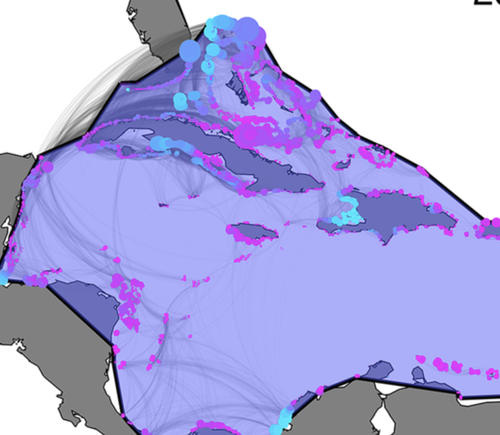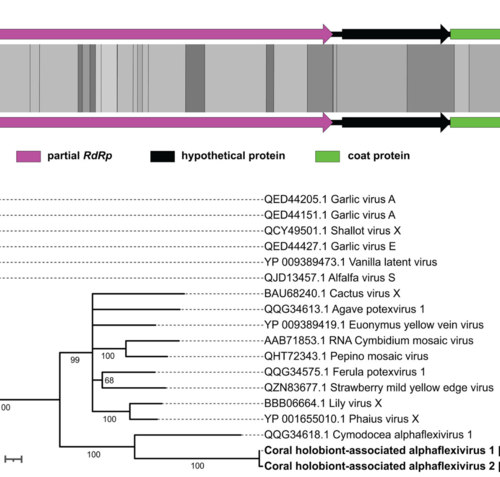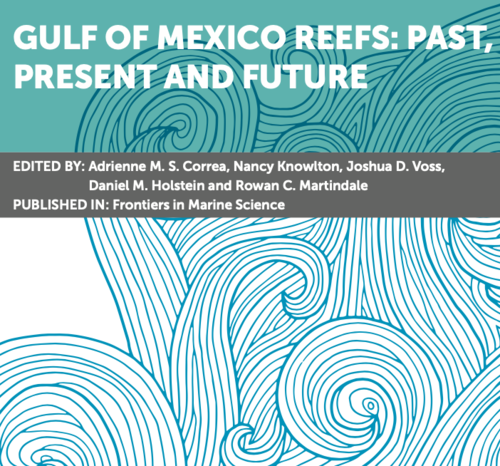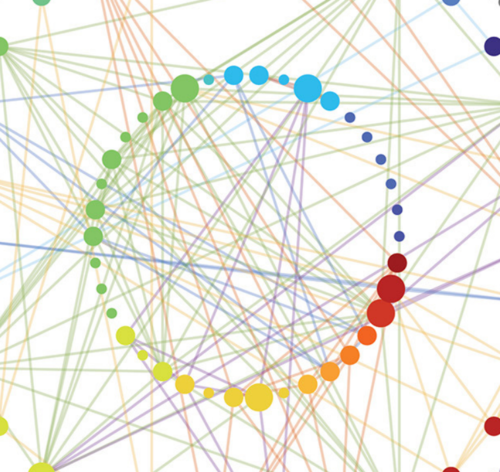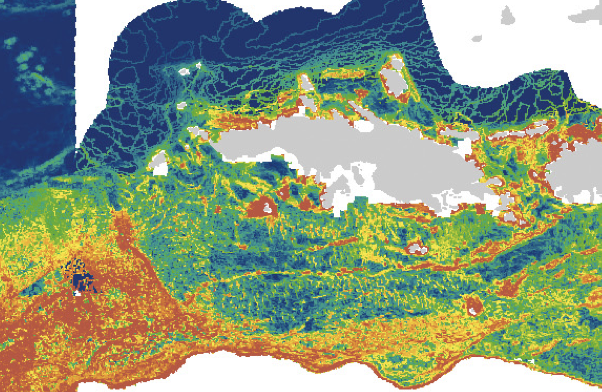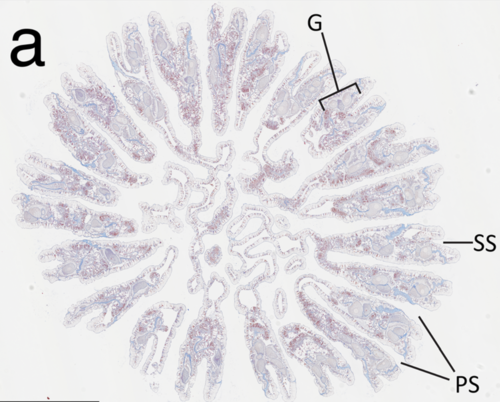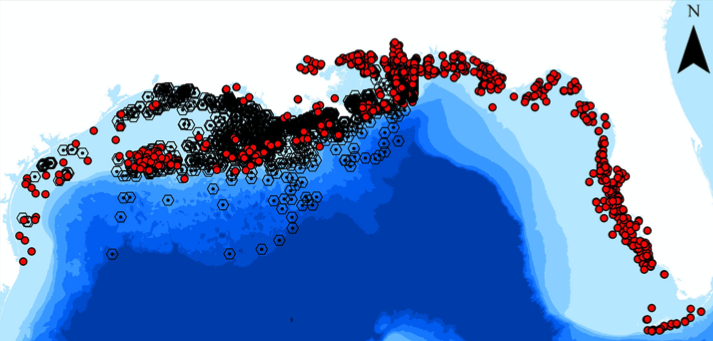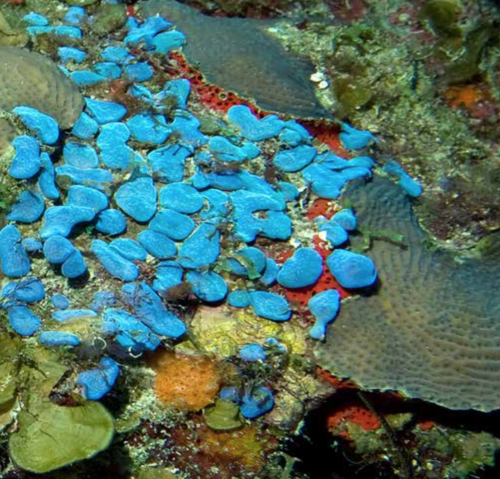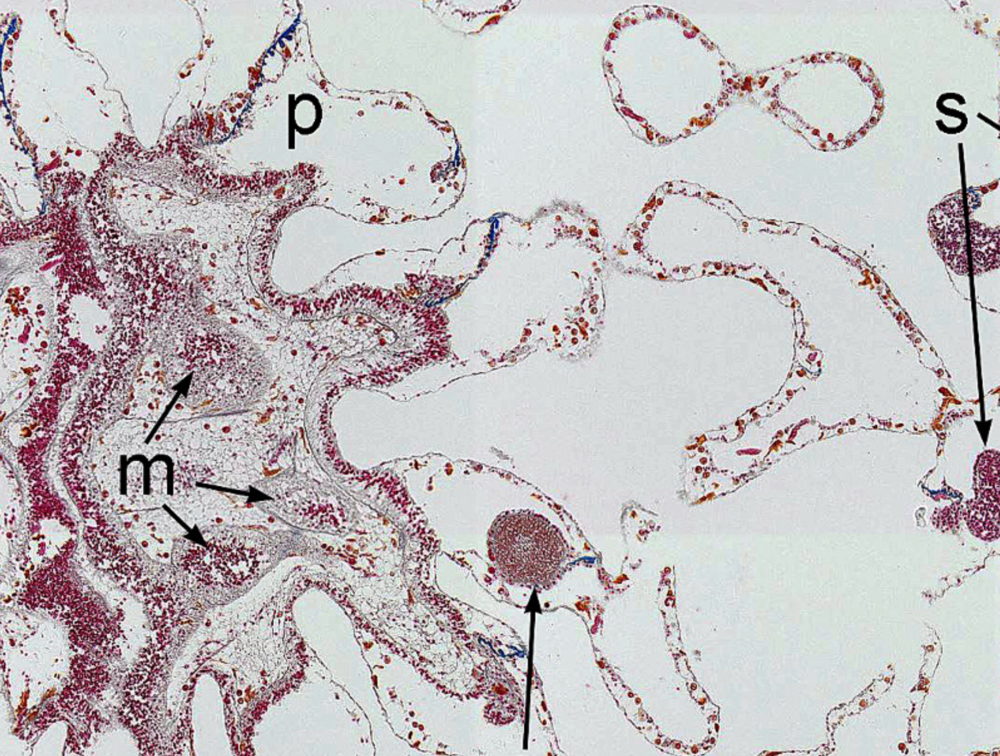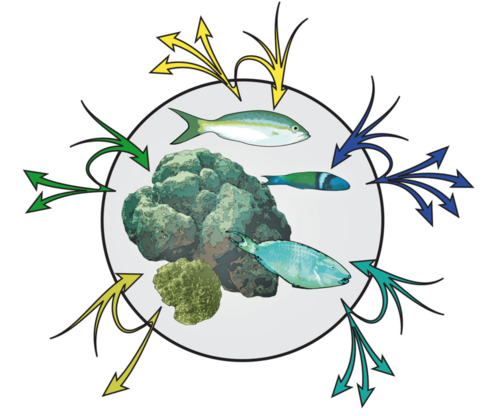Hello!
This is the online home of the Seascape Ecology Lab. Our interests reside at the interface of animal biology, marine ecology, environmental data science, and simulation modeling. We seek to understand how interconnected marine communities respond to global climate changes, and how best to conserve and restore natural marine resources in an uncertain future.
⇩
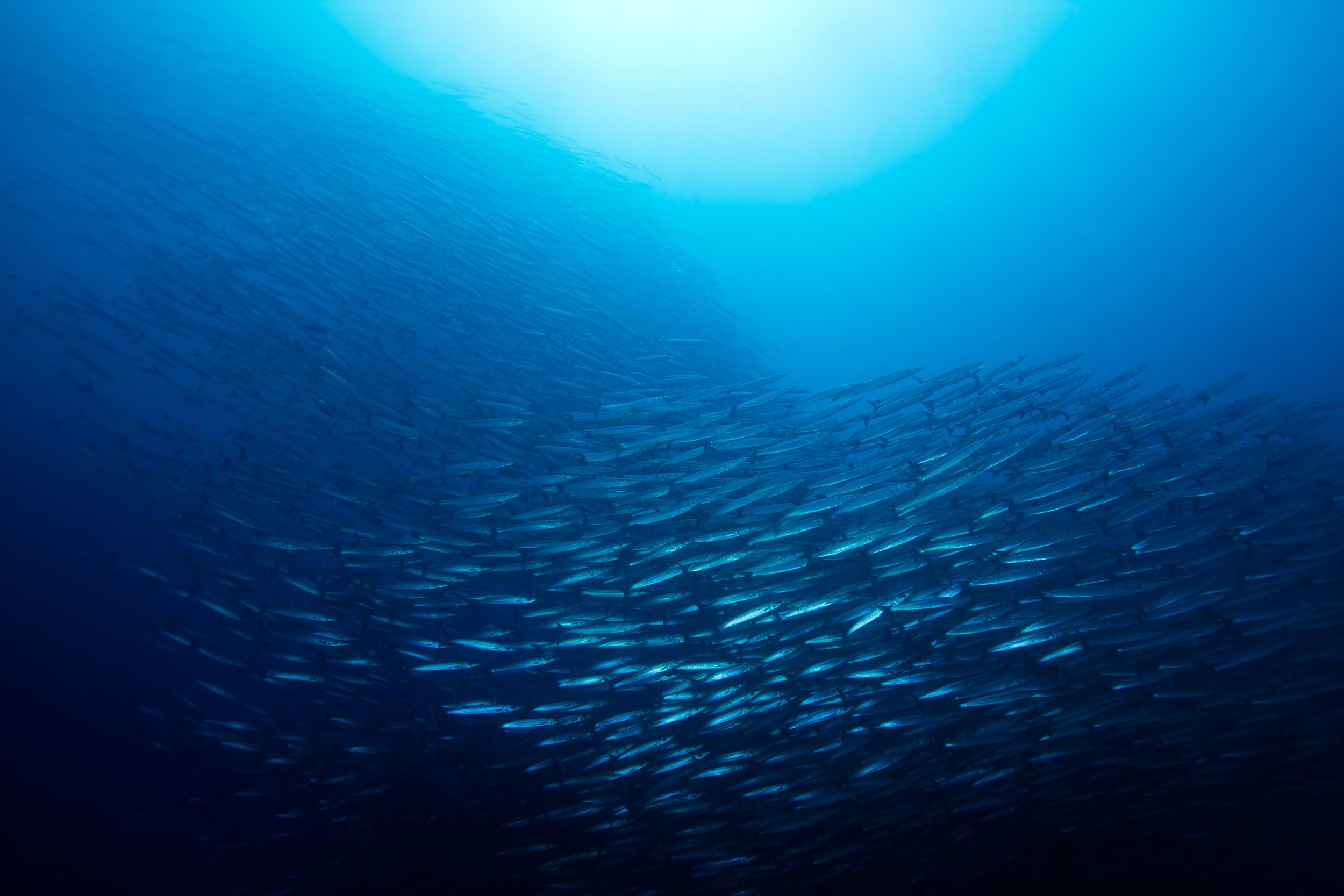
Research
-
Our research revolves around the concept of connected metapopulations. Metapopulations are networks of connected sub-populations. But what connects them? For many marine organisms, these sub-populations are connected by larvae dispersing on ocean currents. In others, adult individuals may move between populations. How connected a metapopulation is – or will be in the future – can determine whether or not it will persist in time and space. We're interested in the application of metapopulation theory to the study and conservation of marine and coastal organisms, and in developing a metapopulation theory of the coastal ocean. Among many ongoing projects, we have an NSF-funded project modeling the effects of climate change on the dispersal and persistence of Florida’s stone crab.
-
Marine larvae are tiny, and notoriously difficult to keep track of. How do we know where larvae from one reef will end up? How do we know where adults on another reef came from? What proportion of adults were born and live in the same place? One way to tackle this complicated set of questions is through larval dispersal modeling. We integrate organismal and larval biology with hydrodynamic models, and use Lagrangian particle tracking to develop probabilities of dispersal and connectivity between habitats.
-
For marine organisms that disperse as larvae, we have an opportunity to inform connectivity and metapopulation modeling by looking at adult reproductive strategy and fecundity, and larval biology and behaviors. For example, we collect coral tissues and utilize reproductive histology and microscopy to investigate the development of gametes in corals in different environments. We also measure minute behaviors of marine larvae throughout development to inform our biophysical modeling.
-
The Seascape Ecology Lab is a part of an NSF EEID-funded effort to understand the transmission and spread of a Stony Coral Tissue Loss Disease in the US Virgin Islands, as well as in Florida with support from Florida’s Department of Environmental Protection. We are looking at multi-species disease signs in coral tissues, and modeling the spread of this disease through coral metacommunities. Previous funding has included three years of support from the Louisiana State Board of Regents to integrate models of coral reproduction, disease, and metapopulation persistence, and NSF RAPID support.
-
Refuges, or refugia, are habitats that are consistently removed from a stress or perturbation. In the case of coral reefs, deeper mesophotic reefs may be one example. Their depth and distance from shore allows corals and associated plants and animals to live in slightly cooler, darker, and less polluted water. But in order for refuges to support metapopulation persistence, connectivity - or the exchange of larvae - must occur at levels that exceeds extinction rates. We're interested in the characterization and mapping of reef refugia, how environmental conditions on mesophotic reefs affects the physiology of reef organisms, and population and community dynamics in these under-explored ecosystems.
-
Through a partnership with Rare’s Fish Forever Initiative (NGO), the Seascape Ecology Lab aids in the design of equitable and fishable marine managed areas in the Philippines, Mozambique, Indonesia, and Central America.
-
National Science Foundation RAPID - Award #2316580 “RAPID: Collaborative Research: Predicting the Spread of Multi-Species Coral Disease Using Species Immune Traits”.
National Science Foundation EEID - Award #2109622 - “A multi-scale approach to predict multi-host disease spread in marine benthic communities”.
National Science Foundation OCE-BIO - Award #2049047 - “Larval orientation, dispersal and connectivity in a brachyuran crab under ocean acidification and elevated temperature”
National Oceanographic and Atmospheric Administration Regional Ecosystem Research Program - “Habitat requirements and ecosystem connectivity of reef-associated fishes in the Gulf of Mexico”
National Science Foundation RAPID - Award #1928771 “RAPID: Collaborative Research: Predicting the Spread of Multi-Species Coral Disease Using Species Immune Traits”.
National Science Foundation VI-EPSCoR RII Track-1: “Ridge to Reef Processes and Interdependent Drivers of Small Island Resilience”.
Florida Department of Environmental Protection - “Extending biophysical and epidemiological simulations of SCTLD on the Florida Reef Tract I & II”.
Florida Department of Environmental Protection - “Coral larval vertical buoyancy/behavior throughout dispersal”.
Louisiana Board of Regents Research Competitiveness Subprogram - “Deep coral refuges in the contexts of emergent disease and reproductive capacity”.
Rare - Contributing Scientist - “Larval Dispersal Modeling for Reserve Design”.
Meet the Team
-

Dan Holstein
Dan is an Assistant Professor in the Department of Oceanography & Coastal Sciences at Louisiana State University. He received his PhD in 2013 from the University of Miami's Rosenstiel School of Marine and Atmospheric Science. Dan is a coral reef ecologist, a biophysical and ecological modeler, and a technical rebreather diver.
Courses: OCS 1005 - Introduction to Oceanography; OCS 4570/7001 - Coral Reef Ecology: Past, Present, & Future; OCS 4007 - Ecology of the Galapagos Islands (field course); OCS 4001 - All About That Bayes
-

Ashley Rossin - Doctoral candidate
Ashley received her bachelor degree in Marine Science and masters in Marine Biology from the University of Maine. Her research interests include coral reproduction and anthropogenic effects on their reproduction, larval development, and energy consumption. She is pursuing her PhD with the Seascape Ecology Lab and will be looking into reproduction of depth-generalist corals in the U.S. Virgin Islands as well as following Stony Coral Tissue Loss Disease throughout the Caribbean. Outside of the lab, Ashley enjoys rock climbing, fishing, and spending time with her dog, Oskar.
-

Ben Farmer - Doctoral candidate
Ben is a 4th-year doctoral candidate who is interested in the roles of community and seascape ecology in the transmission of marine infectious diseases. He completed a B.S. in Biology at the University of Kentucky in 2019, then worked with the School for Field Studies, Turks and Caicos Islands, as a Waterfront Assistant. There, Ben helped document a devastating outbreak of stony coral tissue loss disease (SCTLD). He followed the disease to LSU, where he now models the epidemiology of SCTLD local to Florida and the US Virgin Islands. When not underwater or in front of a computer, Ben makes time to enjoy the wonderful festival and music scenes of Louisiana.
-

Hannah Craft - Doctoral student
Hannah received their bachelor’s degree in Marine and Environmental Biology and Policy and in Chemistry from Monmouth University. Hannah’s research interests include crustacean ecology, impacts of anthropogenic climate change, fishery sustainability, and scientific outreach and education. They are pursuing their PhD with the Seascape Ecology Lab investigating the impacts of ocean acidification and rising water temperatures on the development, behavior, and distribution of larval Florida stone crab. Outside of the lab, Hannah enjoys hiking, making pottery, rock climbing, and thrifting.
email: hcraft2@lsu.edu
-

Gaby Carpenter - Doctoral student
Gaby received her bachelors degree in environmental science and economics from Colby College and masters in marine biology from Northeastern University. Her previous research focused on acclimatization and thermal stress on large benthic foraminifera in Taiwan as well as photoacclimatization in mesophotic corals in Little Cayman. Gaby is originally from Southern California where she first learned to scuba dive in the temperate kelp forests. Since that time, she received her certification as an open water scuba instructor as well as an open-circuit and closed-circuit technical diver. She is pursuing her PhD in the Seascape Ecology Lab studying the ecology of mesophotic coral ecosystems and coral disease.
email: gcarpe3@lsu.edu
-
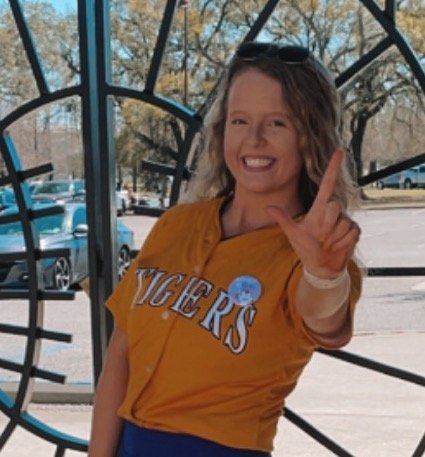
Morgan Coleman - Undergraduate Lab Manager
Morgan is a Junior majoring in Coastal and Environmental Science with a research concentration. She grew up on the coast of south Mississippi, and loves being a Bat Girl for the LSU baseball team, spending time at the beach and islands, and spending time with friends and family.
-

Gillian Coleman - Undergraduate Researcher
Gillian is majoring in Coastal Environmental Science with a research concentration. She is from Hurley, MS, and is a part of LSU Batgirls, likes going to the beach, and spending time with family.
-

Annie Lamke - Undergraduate Researcher
Annie is a junior majoring in Coastal Environmental Science with an applied concentration. Her hometown is Port Barre, Louisiana. Her favorite things are nature, sea turtles, and the ocean, which have heavily influenced her major and love for the environment.
-
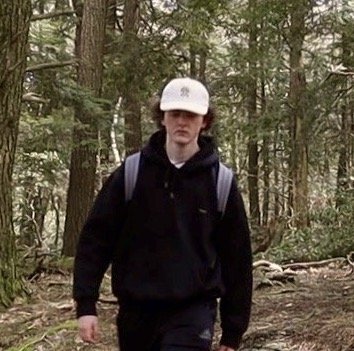
Aran Brancato - Undergraduate Researcher
Aran is a Coastal Environmental Science major from West Hartford, Connecticut. He transferred to LSU’s College of the Coast and Environment, won over by his passions for oceanography and sustainability. He hopes to expand his knowledge of marine ecosystems through research experience, with a goal of bridging gaps between science and law/policy. In his free time, Aran enjoys reading, hiking, and studying urban design.
Lab Alumni
-

Jeanne Bloomberg - Graduated M.Sc.
Jeanne Bloomberg completed her master’s studying coral reproduction across environmental gradients, and in the context of coral disease. She is broadly interested in coral reef restoration and understanding the future of coral reefs. Jeanne completed her B.S. at Northeastern University in marine biology, where she also completed the Three Seas Program. Jeanne completed a fellowship with the National Academy of Sciences, and entered the joint doctoral program at MIT and Woods Hole in Fall 2022. In her free time, she likes to do yoga and play with her dog.
-
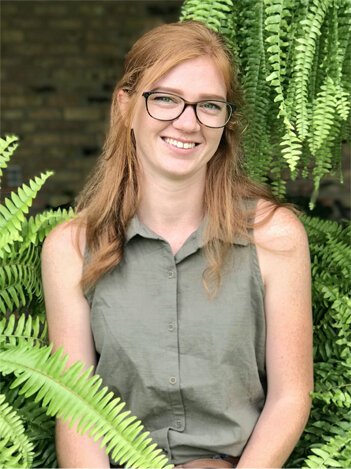
Brittney Green - Graduated Undergraduate Lab Manager
Brittney Green was our first undergraduate lab manager, and led the lab’s NSF-funded research to investigate coral disease signs histologically. She studied marine biology and oceanography. Brittney grew up in San Diego which grew her love for marine sciences. After graduating culinary school and traveling she decided to pursue a career in biology.
-

Ben Limer, PhD
Ben received his bachelor's degree in marine science and biology in 2018 from the Rosenstiel School of Marine and Atmospheric Science at the University of Miami, and his PhD from the Seascape Ecology Lab at LSU in 2023. He has gone on to a Fulbright Postdoctoral Fellowship with the University of Haifa.
Image reproduced and edited with permission from Sammy Katta.
Undergraduate research opportunities
At any given time, we have ~2-10 undergraduates in the lab, assisting our graduate students, and/or conducting independent research. Please get in touch regarding undergraduate research opportunities.
Interested in joining the lab as an undergraduate, M.Sc., Ph.D., or postdoc? Feel free to reach out and discuss your interests in marine ecology.
Selected publications
*Student or committee membership, †award or recognition
2024
Canty SWJ, Nowakowski AJ, Cox CE, Valdivia A, Holstein DM, Limer B*, Lefcheck JS, Craig N, Drysdale I, Giro A, Soto M, McField M (2024) Interplay of management and environmental drivers shift size structure of reef fish communities. Global Change Biology 2024:30:e17257. DOI: 10.1111/gcb.17257.
Papke E, Carreiro A, Dennison C, Deutsch J, Isma LM, Meiling SS, Rossin A*, Baker AC, Brandt M, Garg N, Holstein DM, Traylor-Knowles T, Voss JD, Ushijima B (2024) Stony Coral Tissue Loss Disease: A review of emergence, impacts, etiology, diagnostics, and intervention. Frontiers in Marine Science 10:1321271. DOI: 10.3389/fmars.2023.1321271.
2023
Beavers K, Van Buren E, Rossin A*, Emery M, Velgia A, Karrick C, MacKnight N, Dimos B, Meiling S, Smith T, Apprill A, Muller E, Holstein DM, Correa A, Brandt M, Mydlarz L. (2023) Stony Coral Tissue Loss Disease induces transcriptional signatures of in situ degradation of dysfunctional Symbiodiniaceae. Nature Communications 14:2915. DOI: 10.1038/s41467-023-38612-4.
Viehman TS, Lenihan H, Rosman JH, Storalzzi CD, Goergen EA, Canals MF, Groves SH, Holstein DM, Bruckner AW, Carrick JV, Haus BK, Royster JB, Duvall M, Torres W, Hench JL (2023) Coral restoration for coastal resilience integrating ecology, hydrodynamics, and engineering at multiple scales. Ecosphere e4517. DOI: 10.1002/ecs2.4517.
Muenzel D, Critchell K, Cox C, Campbell S, Jakub R, Chollett I, Krueck N, Holstein DM, Treml E, Beger M (2023) Comparing spatial conservation prioritization methods using site versus spatial dependency-based connectivity. Conservation Biology e14008. DOI: 10.1111/cobi.14008
2022
Studivan MS, Baptist M, Molina V, Riley S, First M, Soderberg N, Rubin E, Rossin A*, Holstein DM, Enochs IC (2022) Transmission of stony coral tissue loss disease (SCTLD) in simulated ballast water confirms the potential for ship-born spread. Scientific Reports 12:19248. DOI: 10.1038/s41598-022-21868-z
Krueck N, Tong CZ , Cox C, Treml E, Critchell K, Chollett I, Adhuri DS, Beger M, Muenzel D, Holstein D, Campbell S, Jakub R (2022) Benefits of measurable population connectivity metrics for area-based marine management. Marine Policy 144, 105210. DOI: 10.1016/j.marpol.2022.105210
Huntley N, Brandt M, Becker C, Miller, CA, Meiling S, Correa A, Holstein DM, Muller E, Mydlarz L, Smith T, Apprill A. (2022) Experimental transmission of Stony Coral Tissue Loss Disease results in differential microbial responses within coral mucus and tissue. ISME Communications 2(1):1-11. DOI: 10.1038/s43705-022-00126-3
Holstein DM, Smith TB, van Hooidonk R, Paris CB (2022) Predicting coral metapopulation decline in a changing thermal environment. Coral Reefs. DOI: 10.1007/s00338-022-02252-9.
Veglia AJ, Beavers K, Van Burent EW, Meiling SS, Muller EM, Smith TB, Holstein DM, Apprill A, Brandt ME, Mydlarz LD, Corea AMS (2022) Novel Alphaflexiviridae genomes with Stony Coral Tissue Loss Disease (SCTLD)-affected, disease-exposed, and unexposed coral colonies in the US Virgin Islands. Microbiology Resource Announcements 11(2):e01199-21. DOI: 10.1128/mra.01199-21.
Dobbelaere T, Holstein DM, Muller EM, Gramer LJ, McEachron L, Williams SD, Hanert E (2022) Connecting the dots: Transmission of stony coral tissue loss disease from the Marquesas to the Dry Tortugas. Frontiers in Marine Science 9:778938. DOI: 10.3389/fmars.2022.778938.
Studivan MS, Rossin AM*, Rubin E, Soderberg, N, Holstein DM, Enochs IC (2022) Reef sediments can act as a stony coral tissue loss disease vector. Frontiers in Marine Science 8:815698. DOI: 10.3389/fmars.2021.815698.
2021
Leinbach SE, Speare KE, Rossin AM*, Holstein DM, Strader ME (2021) Coral recovery, but at a cost: energetic and reproductive consequences of divergent bleaching responses. Scientific Reports 11:23546. DOI: 10.1038/s41598-021-02807-w.
Enochs I, Toth L, Kirkland A, Manzello D, Kolodziej G, Morris J, Holstein DM, Schlenz A, Randal C, Mate J, Leichter J, Aronson R (2021) Upwelling and the persistence of coral-reef frameworks in the eastern tropical Pacific. Ecological Monographs e01482.
Liang JH, Liu J, Benfield M, Justic D, Holstein DM, Liu B, Hetland R, Kobashi D, Dong C, Dong W (2021) Including the effects of subsurface currents on buoyant particles in Lagrangian particle tracking models: Model development and its application to the study of riverborne plastics over the Louisiana/Texas Shelf. Ocean Modeling 167:101879. DOI: 10.1016/j.ocemod.2021.101879.
Holstein DM1, Martindale RC1, Voss JD, Knowlton N, Weiss A, Correa AMS1 (2021) Editorial: Gulf of Mexico Reefs: Past, Present and Future. Frontiers in Marine Science 8:713058. DOI: 10.3389/fmars.2021.713058.
Egan KE*, Viehman TS, Holstein DM, Poti M, Groves SH, Smith TB (2021) Predicting the distribution of threatened orbicellid corals in shallow and mesophotic reef ecosystems. Marine Ecology Progress Series 667:61-81. DOI: 10.3354/meps13698.
Meiling SS, Muller EM, Lasseigne D, Rossin A*, Veglia A, MacKnight N, Dimos B, Huntley N, Correa AMS, Smith TB, Holstein DM, Mydlarz LD, Apprill A, Brandt ME (2021) Variable species responses to experimental stony coral tissue loss disease (SCTLD) exposure. Frontiers in Marine Science 8:670829. DOI: 10.3389/fmars.2021.670829.
Bloomberg J*, Holstein DM (2021) Mesophotic coral refuges following multiple disturbances. Coral Reefs 40(3):821-834. DOI: 10.1007/s00338-021-02087-w.
Pittman SJ, Yates K, Bouchet PJF, Alvarez-Berastegui D, Andréfouët S, Bell SS, Berkström C, Boström C, Brown C, Connolly R, Devillers R, Eggleston D, Gilby BL, Gullström M, Halpern B, Roldan MH, Holstein DM, Hovel K, Huettmann F, Jackson E, James WR, Kellner J, Kot CY, Lecours V, Lepcszyk C, Nagelkerken I, Nelson J, Olds AD, Santos R, Scales KL, Schneider D, Schilling H, Simenstad C, Suthers IM, Treml E, Wedding L, Yates P, Young M (2021) Seascape ecology: Identifying research priorities for an emerging ocean sustainability science. Marine Ecology Progress Series 663:1-29. DOI: 10.3354/meps13661. Selected as Feature Article†.
2020
Dobbelaere T, Muller E, Gramer LJ, Holstein DM, Hanert E (2020) Coupled epidemio-hydrodynamic modeling to understand the spread of a deadly coral disease in Florida. Frontiers in Marine Science 7:591881. DOI: 10.3389/fmars.2020.591881.
Limer BD*, Bloomberg J*, Holstein DM (2020) The influence of eddies on coral larval retention in the Flower Garden Banks. Frontiers in Marine Science 7:372. DOI: 10.3389/fmars.2020.00372.
Schulze A, Erdner DL, Grimes CJ, Holstein DM, Miglietta MP (2020) The complex ecological roles of oil and gas structures in the northern Gulf of Mexico. Frontiers in Marine Science 7:447. DOI: 10.3389/fmars.2020.00447.
2019
Baeza AJ, Holstein DM, Umaña-Castro R, Mejía-Ortíz L (2019) Population genetics and biophysical modeling inform metapopulation connectivity of the Caribbean king crab Maguimithrax spinosissimus. Marine Ecology Progress Series 610:83-97. DOI: 10.3354/meps12842.
Sellers J*, Holstein DM, Botha TL, Sikkel P (2019) Lethal and sublethal impacts of a micropredator on post-settlement Caribbean reef fishes. Oecologia. DOI: 10.1007/s00442-081-4262-8. Highlighted Student Research†.
Holstein DM, Fletcher P, Groves SH, Smith TB (2019) Ecosystems services of mesophotic coral reefs and a call for better accounting. In: Puglise, KA, Bridge, T (Eds.). Coral Reefs of the World Mesophotic Coral Ecosystems. Springer.
Smith TB, Brandt ME, Brandtneris VW, Ennis RS, Groves SH, Habtes S, Holstein DM, Kadison E, Nemeth RS (2019) United States Virgin Islands. In: Puglise, KA, Bridge, T (Eds.). Coral Reefs of the World: Mesophotic Coral Ecosystems. Springer.
Smith TB, Holstein DM, Ennis R (2019) Disturbance in mesophotic coral ecosystems and strategies for conservation and management. In: Puglise, KA, Bridge, T (Eds.). Coral Reefs of the World: Mesophotic Coral Ecosystems. Springer.
2018
Groves SH, Holstein DM, Enochs IC, Kolodzeij G, Manzello DP, Brandt ME, Smith TB (2018) Growth rates of Porites astreoides and Orbicella franksi in mesophotic habitats surrounding St. Thomas, US Virgin Islands. Coral Reefs 37(2);345-354. DOI: 10.1007/s00338-018-1660-7.
2017
Chollett I, Garavelli L, Holstein DM, Cherubin L, Box SJ (2017) A case for redefining the boundaries of the Mesoamerican Reef Ecoregion. Coral Reefs 36(4):1039-1046. DOI: 10.1007/s00338-017-1595-4.
2016
Smith TB, Brandtneris VW, Canals MC, Brandt ME, Martens J, Brewer R, Kadison E, Kammann M, Keller J, Holstein DM (2016) Potential structuring forces on a shelf edge upper mesophotic coral ecosystem in the US Virgin Islands. Frontiers in Marine Science 3:115. DOI: 10.3389/fmars.2016.00115.
Holstein DM, Smith TB, Paris CB (2016) Depth-independent reproduction in the reef coral Porites astreoides from shallow to mesophotic zones. PLOS ONE 11(1): e0146068. DOI: 10.1371/journal.pone.0146068.
Holstein DM, Paris CB, Vaz A, Smith TB (2016) Modeling vertical coral connectivity and mesophotic refugia. Coral Reefs 35:23, DOI: 10.1007/s00338-015-1339-2. Winner of ISRS Best Paper Award†.
Holstein DM, Smith TB, Appeldoorn RS (2016) Chapter 5. Ecosystem services provided by mesophotic coral ecosystems. In: Baker, EK, Puglise, KA and Harris, PT (Eds.). (2016). Mesophotic coral ecosystems — A lifeboat for coral reefs? (pp. 26-27). The United Nations Environment Programme and GRID-Arendal, Nairobi and Arendal.
Smith TB, Holstein DM (2016) Chapter 3.4. Mesophotic Reefs Examined: The United States Virgin Islands, USA. In: Baker, EK, Puglise, KA and Harris, PT (Eds.). (2016). Mesophotic coral ecosystems — A lifeboat for coral reefs? (pp. 63-66). The United Nations Environment Programme and GRID-Arendal, Nairobi and Arendal.
2015
Holstein DM, Smith TB, Gyory J, Paris CB (2015) Fertile fathoms: Deep reproductive refugia for threatened shallow corals. Scientific Reports 5: 12407, DOI: 10.1038/srep12407.
2014
Holstein DM, Paris CB, Mumby PJ (2014) Consistency and inconsistency in multispecies population network dynamics of coral reef ecosystems. Marine Ecology Progress Series 499:1-18, DOI: 10.3354/meps10647. Selected as Feature Article†.
If you find that any of our publications are behind a paywall and you would like a copy for personal use, please do not hesitate to request one by email.











